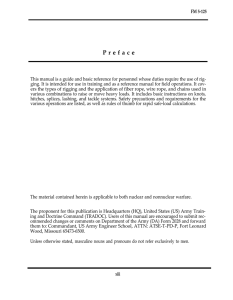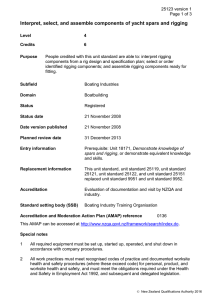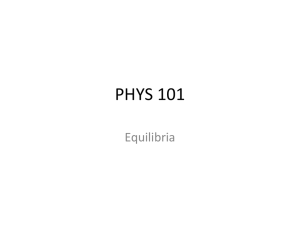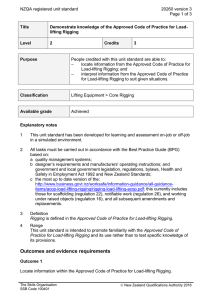NZQA registered unit standard 26351 version 2 Page 1 of 4
advertisement
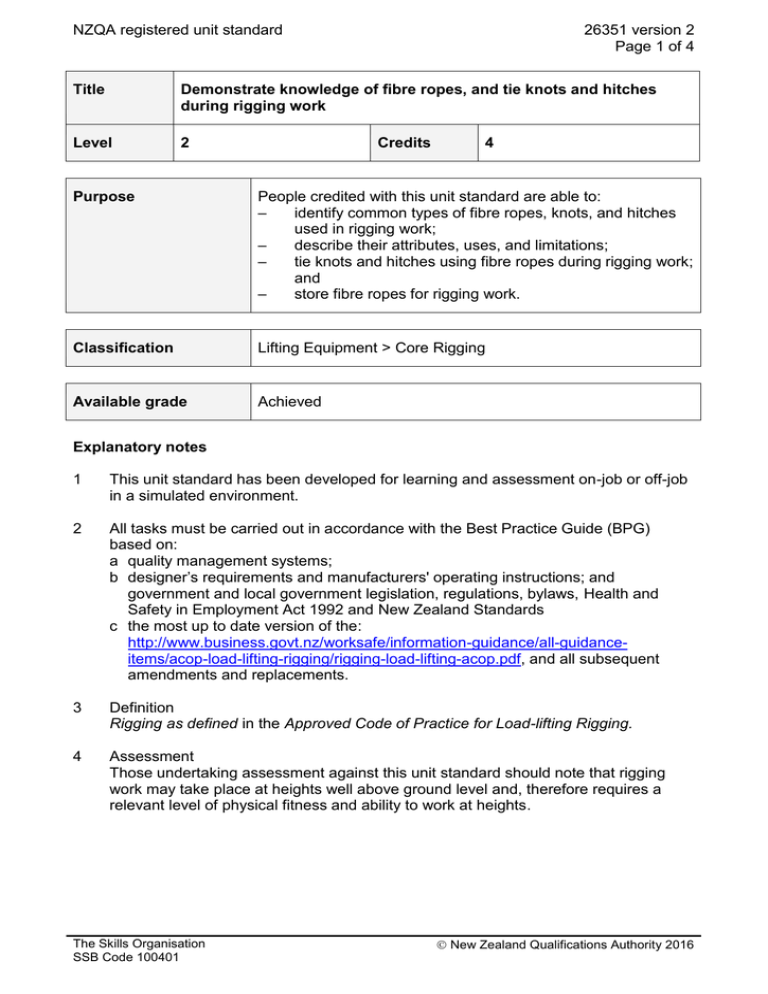
NZQA registered unit standard 26351 version 2 Page 1 of 4 Title Demonstrate knowledge of fibre ropes, and tie knots and hitches during rigging work Level 2 Credits 4 Purpose People credited with this unit standard are able to: – identify common types of fibre ropes, knots, and hitches used in rigging work; – describe their attributes, uses, and limitations; – tie knots and hitches using fibre ropes during rigging work; and – store fibre ropes for rigging work. Classification Lifting Equipment > Core Rigging Available grade Achieved Explanatory notes 1 This unit standard has been developed for learning and assessment on-job or off-job in a simulated environment. 2 All tasks must be carried out in accordance with the Best Practice Guide (BPG) based on: a quality management systems; b designer’s requirements and manufacturers' operating instructions; and government and local government legislation, regulations, bylaws, Health and Safety in Employment Act 1992 and New Zealand Standards c the most up to date version of the: http://www.business.govt.nz/worksafe/information-guidance/all-guidanceitems/acop-load-lifting-rigging/rigging-load-lifting-acop.pdf, and all subsequent amendments and replacements. 3 Definition Rigging as defined in the Approved Code of Practice for Load-lifting Rigging. 4 Assessment Those undertaking assessment against this unit standard should note that rigging work may take place at heights well above ground level and, therefore requires a relevant level of physical fitness and ability to work at heights. The Skills Organisation SSB Code 100401 New Zealand Qualifications Authority 2016 NZQA registered unit standard 26351 version 2 Page 2 of 4 Outcomes and evidence requirements Outcome 1 Identify common types of fibre ropes used in rigging work and describe their attributes, uses, and limitations. Evidence requirements 1.1 Identify common types of fibre ropes. Range 1.2 at least five types of rope. Describe the attributes, uses, and limitations of common types of fibre ropes. Range attributes may include but are not limited to – susceptibility to rot, abrasion resistance, stretch, flexibility, cost; evidence of at least one attribute, one use, and one limitation for each of five types of rope is required. Outcome 2 Identify common knots and hitches used in rigging work and describe their attributes, uses, and limitations. Evidence requirements 2.1 Identify common knots and hitches. Range 2.2 includes but is not limited to – sheet bend, bowline, reef knot, figure eight knot, timber hitch, clove hitch, round turn and two half hitches, rolling hitch, sheepshank; evidence of at least three knots and three hitches is required. Describe the attributes, uses, and limitations of common knots and hitches. Range The Skills Organisation SSB Code 100401 attributes may include but are not limited to – ease of tying and undoing, resistance to slipping, common applications; evidence of at least one attribute, one use, and one limitation for each of three knots and three hitches is required. New Zealand Qualifications Authority 2016 NZQA registered unit standard 26351 version 2 Page 3 of 4 Outcome 3 Tie knots and hitches when using fibre ropes during rigging work. Range evidence of rigging work in three different contexts is required; contexts may include but are not limited to – working with overhead cranes; working with mobile cranes; movement of equipment and materials using chain blocks, turfers or other rigging equipment. Evidence requirements 3.1 Use fibre rope to tie knots and hitches during rigging work. Range applications may include but are not limited to – securing tag lines, positioning wire rope for re-roping cranes, securing loads, joining ropes of equal and unequal diameter, tying off slack lines and lines under tension; knots and hitches may include but are not limited to – sheet bend, bowline, reef knot, figure eight knot, timber hitch, clove hitch, round turn and two half hitches, rolling hitch, sheepshank. Outcome 4 Store fibre ropes for rigging work. Evidence requirements 4.1 Inspect ropes for damage. Range 4.2 Identify and dispose of unsuitable ropes. Range 4.3 may include but is not limited to – rot and mildew, cuts and abrasions, melts and chemical attack, broken fibres, bird caging. may include but is not limited to – old, worn, damaged, not fit for purpose. Prepare and stow ropes for storage. Range Planned review date The Skills Organisation SSB Code 100401 may include but is not limited to – removal of contaminants, coiling up and securing. 31 December 2019 New Zealand Qualifications Authority 2016 NZQA registered unit standard 26351 version 2 Page 4 of 4 Status information and last date for assessment for superseded versions Process Version Date Last Date for Assessment Registration 1 22 October 2010 31 December 2016 Review 2 16 July 2015 N/A Accreditation and Moderation Action Plan (AMAP) reference 0003 This AMAP can be accessed at http://www.nzqa.govt.nz/framework/search/index.do. Please note Providers must be granted consent to assess against standards (accredited) by NZQA, or an inter-institutional body with delegated authority for quality assurance, before they can report credits from assessment against unit standards or deliver courses of study leading to that assessment. Industry Training Organisations must be granted consent to assess against standards by NZQA before they can register credits from assessment against unit standards. Providers and Industry Training Organisations, which have been granted consent and which are assessing against unit standards must engage with the moderation system that applies to those standards. Consent requirements and an outline of the moderation system that applies to this standard are outlined in the Accreditation and Moderation Action Plan (AMAP). The AMAP also includes useful information about special requirements for organisations wishing to develop education and training programmes, such as minimum qualifications for tutors and assessors, and special resource requirements. Comments on this unit standard Please contact The Skills Organisation at reviewcomments@skills.org.nz if you wish to suggest changes to the content of this unit standard. The Skills Organisation SSB Code 100401 New Zealand Qualifications Authority 2016
